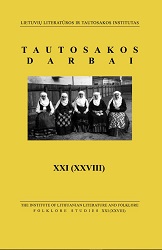AUKŠTAITIŠKOS IR ŽEMAITIŠKOS TRADICIJŲ SAMPYNA CIPRIJONO NIAUROS SMUIKO MUZIKOJE
FUSION OF THE EASTERN AND WESTERN LITHUANIAN TRADITIONS IN CIPRIJONAS NIAURA’S FIDDLE MUSIC
Author(s): Gaila KIRDIENĖSubject(s): Cultural history, Customs / Folklore, Music, History of Art
Published by: Lietuvių literatūros ir tautosakos institutas
Keywords: Eastern and Western Lithuanian traditions; Ciprijonas Niaura; Fiddle music; folk tradition;
Summary/Abstract: Folk fiddler Ciprijonas Niaura (1896– ~1983) was born in Rokiškis region, Svėdasai district (eastern Lithuania), and was living in Telšiai region, Luokė district, Kinčiuliai village (western Lithuania, or Samogitia). Music performed by him seems to be quite outstanding in the context of the traditional fiddle music of Luokė district. As one of the main reasons for such a phenomenon, the eastern Lithuanian origin of the musician is considered. The author aims at revealing how this musician integrated himself into the Samogitian fiddling tradition, what new pieces and ways of playing he had to adopt, and what he was able to retain. Therefore music performed by Niaura and his contemporary fiddlers from Samogitia (Luokė district) and the eastern Lithuanian districts close to Svėdasai is compared. The regional and other peculiarities of Lithuanian folk fiddle music (and many other instruments as well) still have not been sufficiently investigated. In order to enable more precise and exhaustive investigations, information regarding the musician’s life and circumstances of learning (or sometimes composing) and performing his pieces is necessary. Such information is significantly lacking in the earlier recordings of instrumental music. Thus it is very important to have such information enriched even today, when assimilation processes of traditions gather both speed and proportions. Detailed information regarding Niaura’s life would enable us to come up with more exact timing of his leaving the native places. However, his biographic data collected by the author, along with fiddle music analysis allow us assuming that this event must have taken place when the musician had already acquired his eastern Lithuanian repertoire and formed his fiddling style, thus approximately at the age of 20.
Journal: Tautosakos darbai
- Issue Year: 2005
- Issue No: 29
- Page Range: 135-153
- Page Count: 19
- Language: Lithuanian

